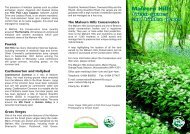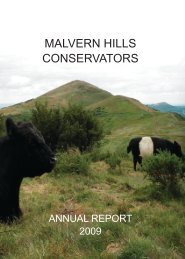Footpath degradation of the Malvern Hills - Malvern Hills Conservators
Footpath degradation of the Malvern Hills - Malvern Hills Conservators
Footpath degradation of the Malvern Hills - Malvern Hills Conservators
You also want an ePaper? Increase the reach of your titles
YUMPU automatically turns print PDFs into web optimized ePapers that Google loves.
Stephen Britnell<br />
<strong>Footpath</strong> <strong>degradation</strong> <strong>of</strong> <strong>the</strong> <strong>Malvern</strong> <strong>Hills</strong><br />
Vogler et al. (1996) looks at footpath erosion on a University campus at a small scale.<br />
Studying path erosion in an urban environment is a different approach to one at a rural upland<br />
environment level, such as <strong>the</strong> <strong>Malvern</strong> <strong>Hills</strong>. However, similar measurements were taken <strong>of</strong><br />
length, depth, and width, though in less detail. Vogler et al. (1996) generally does not focus<br />
on environmental variables in detail, such as slope angle, rainfall, and vegetation cover,<br />
although does explore <strong>the</strong> causal factors for high erosion levels <strong>of</strong> certain paths. They deduce<br />
that high levels <strong>of</strong> erosion are due to people pressure at two sites, and high slope angle at<br />
ano<strong>the</strong>r two. Overall Vogler et al. (1996) work is a useful addition to <strong>the</strong> study <strong>of</strong> path erosion<br />
fro a unique urban perspective.<br />
1.2.3 Path <strong>degradation</strong> studies<br />
The main objectives <strong>of</strong> <strong>the</strong> paper Leung et al. (1996) trail <strong>degradation</strong> as influenced<br />
by environmental factors: a state-<strong>of</strong>-knowledge review, are threefold. Firstly to clarify terms<br />
used in trail condition research. Secondly to asses <strong>the</strong> development <strong>of</strong> trail <strong>degradation</strong><br />
research, and finally, to review and summarise <strong>the</strong> influence <strong>of</strong> environmental factors<br />
affecting trail <strong>degradation</strong>.<br />
Leung et al. (1996) have developed a classification system for trail research. (See<br />
Table 1). They split research into four classes, path impact, path deterioration, path<br />
<strong>degradation</strong> and path erosion. Path impact is <strong>the</strong> most general term, and is concerned with all<br />
physical, ecological , and aes<strong>the</strong>tic factors. Path deterioration studies are distinguished by<br />
<strong>the</strong>ir inclusion <strong>of</strong> path proliferation and vegetation assessments, and general focus <strong>of</strong> a<br />
landscape scale. These form <strong>of</strong> studies are extreme in <strong>the</strong> fact that <strong>the</strong>y consider <strong>the</strong> very<br />
existence <strong>of</strong> paths as a form <strong>of</strong> impact on <strong>the</strong> natural landscape. Path <strong>degradation</strong> studies<br />
focus on <strong>the</strong> effects <strong>of</strong> path use on <strong>the</strong> surface after <strong>the</strong>y are formed. This type <strong>of</strong> research<br />
accepts <strong>the</strong> necessity <strong>of</strong> paths in natural areas as a means <strong>of</strong> protection. Finally, path<br />
erosion, which is <strong>the</strong> most restrictive term, relates specifically to assessments <strong>of</strong> processes<br />
4





